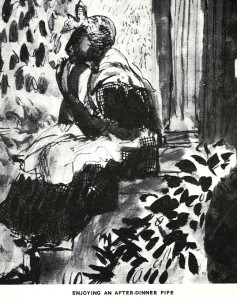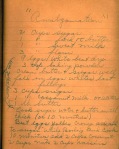Southerners share an acute awareness that most of our fellow countrymen view us with disdain. This knowledge of ill regard is something we learn from an early age, and the message is amplified and compounded by a steady stream of negativity from every imaginable source: books, movies, television and other media, not to mention personal experiences garnered by traveling outside our lands and meeting that contempt face-to-face.
As powerful as this imprint is, still it can come as a shock, particularly for a Mississippian, who even among their fellows from other Southern states are pissed upon as if from a great height, to find that a person you admire for talent, wisdom, and at least an ostensible generosity of mind can be vehemently bigoted towards a region and people never visited. Such was my reaction to Bill Bryson’s account of a visit to Mississippi in The Lost Continent: Travels in Small-Town America, in which Bryson chronicles a 13,978 mile trip around the United States in the autumn of 1987 and spring 1988.
When I was a graduate student studying English as a language, Bryson’s The Mother Tongue: English and How It Got That Way (1990) captivated me. Witty, informative and occasionally dazzlingly well-written,–he hangs 10 all through Middle English–Bryson came across as the bluff, jovial professor of the sort one should hope to have in a subject that can be stupefying.
Many years later, when I came across Bryson’s account of his journey through Mississippi in The Lost Continent, I was stunned to discover him, a native Iowan now living in Britain, as full of bile as most American writers who venture south and dismayed to find his account packed with the usual shopworn stereotypes, clichés, and overt contempt. Here’s some of what he wrote.
Just south of Grand Junction, Tennessee, I passed over the state line into Mississippi. A sign beside the highway said, WELCOME TO MISSISSIPPI. WE SHOOT TO KILL. (my emphasis, jly) It didn’t really. I just made that up. This was only the second time I had ever been to the Deep South and I entered it with a sense of foreboding. It is surely no coincidence that all those films you have ever seen about the South – Easy Rider, In the Heat of the Night, Cool Hand Luke, Brubaker, Deliverance – depict Southerners as murderous, incestuous, shitty-shoed rednecks. It really is another country.
…
I followed Highway 7 south towards Oxford. It took me along the western edge of the Holly Springs National Forest which seemed to be mostly swamp and scrub land. I was disappointed. I had half expected that as soon as I crossed into Mississippi there would be Spanish mosses (sic) hanging from the trees and women in billowy dresses twirling parasols and white-haired colonels with handlebar mustaches drinking mint juleps on the lawn while armies of slaves gathered the cotton and sang sweet hymns. But this landscape was just scrubby and hot and nondescript. Occasionally there would be a shack set up on bricks, with an old black man in a rocking chair on the porch, but precious little sign of life or movement elsewhere.
At the town of Holly Springs stood a sign for Senatobia, and I got briefly excited. Senatobia! What a great name for a Mississippi town! All that the old South stood for seemed to be encapsulated in those five golden syllables. Maybe things were picking up. Maybe now I would see chain gangs toiling in the sun and a prisoner in heavy irons legging it across fields and sloshing through creeks while pursued by bloodhounds, and lynch mobs roaming the streets and crosses burning on lawns. The prospect enlivened me, but I had to calm down because a state trooper pulled up alongside me at a traffic light and began looking me over with that sort of casual disdain you often get when you give a dangerously stupid person a gun and a squad car. He was sweaty and overweight and sat low in his seat. I assume he was descended from the apes like all the rest of us, but clearly in his case it had been a fairly gentle slope. I stared straight ahead with a look that I hoped conveyed seriousness of purpose mingled with a warm heart and innocent demeanor. I could feel him looking at me. At the very least I expected him to gob a wad of tobacco juice down the side of my head. Instead, he said, “How yew doin’?” This so surprised me that I answered, in a cracking voice, “Pardon?”
“I said, how yew doin’?”
“I’m fine,” I said. And then added, having lived some years in England, “Thank you.”
“Y’on vacation?”
“Yup”
“Hah doo lack Miss Hippy?”
I was quietly distressed. The man was armed and Southern and I couldn’t understand a word he was saying to me. “I’m sorry,” I said, “I’m kind of slow, and I don’t understand what you’re saying.”
“I say” – and he repeated it more carefully – “how doo yew lack Mississippi?”
It dawned on me. “Oh! I like it fine! I like it heaps! I think it’s wonderful. The people are so friendly and helpful.” I wanted to add that I had been there for an hour and hadn’t been shot at once, but the light changed and he was gone, and I signed and thought, “Thank you, Jesus.”
I drove on to Oxford, home of the University of Mississippi, or Ole Miss as it’s known. The people named the town after Oxford in England in the hope that this would persuade the state to build the university there, and the state did. This tells you most of what you need to know about the workings of the Southern mind. Oxford appeared to be an agreeable town. It was built around a square, in the middle of which stood the Lafayette County Courthouse, with a tall clock tower and Doric columns, basking grandly in the Indian-summer. Around the perimeter of the square were attractive stores and a tourist information office. I went into the tourist information office to get directions to Rowan Oak, William Faulkner’s home.
…
Behind the desk sat a large, exceptionally well-dressed black woman. This surprised me a little, this being Mississippi. She wore a dark two-piece suit, which must have been awfully warm in the Mississippi heat. I asked her the way to Rowan Oak. “You parked on the square?” she said. Actually she said, “You pocked on the skwaya?”
“Yes.”
“Okay, honey, you git in yo’ car and makes the skwaya. You goes out the other end, twoads the university, goes three blocks, turns rat at the traffic lats, goes down the hill and you there, un’stan?”
“No.”
She sighed and started again. “You git in yo’ car and makes the skwaya–”
“What, I drive around the square?”
“That’s rat, honey. You makes the skwaya.” She was talking to me the way I would talk to a French person. She gave me the rest of the instructions and I pretended to understand, though they meant nothing to me. All I kept thinking was what funny sounds they were to be emerging from such an elegant-looking woman. As I went out the door she called out, “Hit doan really matter anyhow cust hit be’s closed now.” She really said hit; she really said be’s.
I said, “Pardon?”
“Hit be’s closed now. You kin look around the grounz if you woan, but you cain’t go insod.”
I wint outsod thinking that Miss Hippy was goan be hard work.
There’s more; some worse, some better. Bryson visited Tupelo and Columbus as well, but in the final analysis. he left Mississippi with pronounced relief, and his impressions of the state were, I’m disappointed to say, rather much what we have come to expect of most people who visit with preconceived prejudices and with no desire to do anything more than capitalize upon the surety that their condescension would be well received by the world at large.
Then again, perhaps something akin to sour grapes may involved. Bryson never got around to finishing that screenplay of Absalom, Absalom!, likely because his diminuating, dismissive assessment of the Southern mind rendered him incapable of encompassing–much less fathoming–Faulkner’s world.












